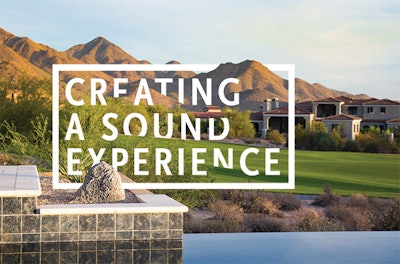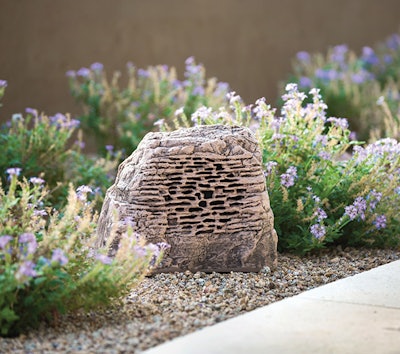
Outdoor sound systems are fun. Whether you're playing Bach or the Beatles, hip-hop or country, incorporating sound adds an enjoyable dimension to almost any space.
Like fire features, outdoor kitchens and lighting, sound systems are a natural fit for the backyard. However, they are often overlooked in the design process. MSE Audio, a maker of sound equipment for both indoors and outdoors, is taking on the professional aquatic/ landscape market with a host of products designed to make the job easier and ultimately more accessible for homeowners.
Knowing that sound systems are relatively unfamiliar to many in our industry, Jonathan Duran, the company's director of residential sales and marketing, shared a rundown of outdoor sound systems basics.
WIRED OR WIRELESS
When it comes to audio systems, homeowner expectations are often driven by the way they have experienced their stereos indoors.
"The first question we get these days is almost always, 'Is it wireless?'" Duran says. "We're at the point where there's a real convergence between the two worlds. Wireless technology has become ubiquitous in the consumer market; you set a speaker down somewhere and it's run off Bluetooth and it's not a permanent installation, it's a very easy and moveable sound source."
The answer to that perennial question? An outdoor speaker system will always be wired, a fact that often comes as a surprise to consumers.
"We have to get over that initial bump with people by explaining that you're putting tremendous resources into your pool and your outdoor kitchen and landscape — doesn't it also make sense to install an audio system that will be there just as long and perform just as well as any other feature in the landscape?"
While wireless speaker systems provide ease and convenience, the nature of outdoor applications heavily favors permanently installed systems that run on low-voltage wiring for several reasons. For one, even wireless speakers need to be wired to an AC outlet when their batteries run low. Second, most wireless components are not made for outdoor applications. Third and most importantly: Wireless speakers simply don't sound good enough.
RELATED: Amplifying the Backyard with Audio/Visual Design
 Speakers like this one can be virtually indistinguishable from the surrounding environment.
Speakers like this one can be virtually indistinguishable from the surrounding environment.
"When you're powering something off of a battery, it can be very difficult to get quality audio because of how power hungry speakers are," Duran explains. "We want all our speakers powered by legitimate amplifiers because they're legitimate quality speakers. They perform at a level beyond what a typical Bluetooth speaker would."
Speakers can be wired one of two ways. Everything can be run with low impedance, where each speaker has a home run back to an amplifier, or you can run a 70-volt system and daisy chain the speakers one after the next. In both cases, wiring for speakers is almost always done using direct burial cable instead of conduit and junction boxes. Which method you choose depends largely on the size of the space.
"In the commercial world we'll use the 70-volt system because you're dealing with 20 or 30 or more speakers, so it's more practical to wire them in sequence. It's much easier than having a home run for each speaker," he says. "In a residential system, even if it's a relatively large yard, you're probably only going to have four to six speakers total, so it's much easier to wire them directly back to the amplifier. That's especially true with our amps that can live outside. So you can place them in a location where it's very convenient to wire them to each speaker separately.
Duran adds that it's while it is easier to use multiple speakers in the 70-volt system, that convenience comes at the cost of audio quality. The daisy-chain setup pushes all sound through a transformer, which doesn't provide as much power to each speaker, preventing the speakers from performing at their optimum level.
SEPARATE SYSTEMS
As noted above, it's important to realize outdoor audio is very different from indoor audio. Indoor systems exist within contained and controlled spaces. By contrast, outdoor systems are not contained and are therefore subject to uncontrolled variables, such as noise from traffic or wind.
"In the outdoor setting, generally speaking, acoustics goes out the window," Duran says. "You don't really have containment surfaces or control over ambient noise levels, which can change outside. There's no boundary boxes or anything for sound waves to bounce off of and be contained."
That fundamental difference, he explains, influences the way speakers are designed from the very start, as well as how they are located within a given area. "The way we compensate for that is with our engineering and speaker design process, where we tune and adjust the designs based on the performance in an outdoor environment instead of an engineering room, where you have all these surfaces that contain sound and things like the bass is reinforced. By engineering them in outdoor spaces, we can ensure that they will perform as best as possible in the setting."
Those key distinctions lead to the next big question: Is the outdoor system intended to serve as an extension of an indoor system, or to function completely separately?
Duran says that in the past, the vast majority of outdoor speaker installations involved expanding an indoor system into the outside. In more recent years, he says, "We're being asked to create a system that is totally divorced from any indoor system. Nowadays, the majority of people coming to us for systems are not bringing it from out of the house in to the backyard.
"We find that's very true, especially for the pool category," he adds. "The backyard is their realm, that's what they're doing, so it makes sense to them to create a completely separate system."
AESTHETICS AND DISTANCE
In the world of outdoor audio, Duran says the two biggest considerations are the physical aesthetics of the speakers and their ability to adequately cover the desired space.
 Outdoor speakers can also be dual-purpose, like this speaker that doubles as a planter.
Outdoor speakers can also be dual-purpose, like this speaker that doubles as a planter.
"Our company is unique because we have so many different types of speakers," he says. "The main thing people want is a nice aesthetic. That's why we have speakers that look like rocks, we have speakers that look like landscape lighting, we have speakers that are built into hardscape materials as well as speakers that look like flowerpots and other objects. We know that people's backyards are now designed as meticulously as the inside of the house and they want a look that fits into their design scheme."
Once you settle on a look, the next consideration is the size of space you want to cover. That will dictate the size of the speaker, the power it requires, the drivers it has and other characteristics, like how much bass the system is capable of. "We always try to get people to bring us images, blueprints or layouts so we can design the system they should consider given the space and how they plan on using the system," Duran says.
RELATED: Sell the Products AROUND the Pool
"We can then help them determine the best location for the speakers and the types of speakers so they can achieve the aesthetics and the coverage they need, so the system performs the best it can."
In the system design phase, he says, speaker selection is largely about distance and direction. "That's pretty much the only qualifier in terms of speaker performance," he says. "The space a given speaker covers is all about its components, such as the driver and crossover networks, etc. It's up to us to help guide the installer as to what speakers will cover a given distance with a given level of sound quality.
"Some speakers are built to be much more dynamic and cover a great spectrum of frequency. By contrast, if you're installing a system for sound masking, you'll use speakers that are less dynamic with small drivers. Speakers that are designed for music might be three-way speakers with subwoofers. They'll be designed to perform a much broader range of frequency."
AUDIO ZONES
Designers also must consider whether the sound system needs to be divided into sections. "You often have kitchens, gazebos, hot tubs and lounging areas, places where people do different things...especially in larger projects. Many consumers want to control different area independently," Duran says.
Finally, there's the issue of where you locate the equipment that drives the system. Traditionally, receivers, CD players, equalizers, mixers, pre-amps and amps were mounted in elaborate equipment racks that had to be located safely indoors. With miniaturization and the ability to create weather-rated components, that has all changed.
"For outdoor systems, we wanted to solve the issue of a traditional equipment rack," Duran says. "We decided to design an amplifier, an integrated component that that is outdoor rated and can be used to supply all the speakers. It can be set up any number of ways in terms of inputs, including being able to be part of a Wi-Fi network or a simple Bluetooth amplifier."
Thanks to advances in speaker technology, improved aesthetics and more-flexible amplifier components, outdoor audio is only growing in popularity. "Whether you want to listen to music or simply mask ambient noise, there are components now available that can meet wide spectrum of audio preferences," Duran says. "We're finding more and more people who work in the pool and spa world are taking on outdoor sound. It's a fantastic way to increase the consumer experience and increase the bottom line."








































